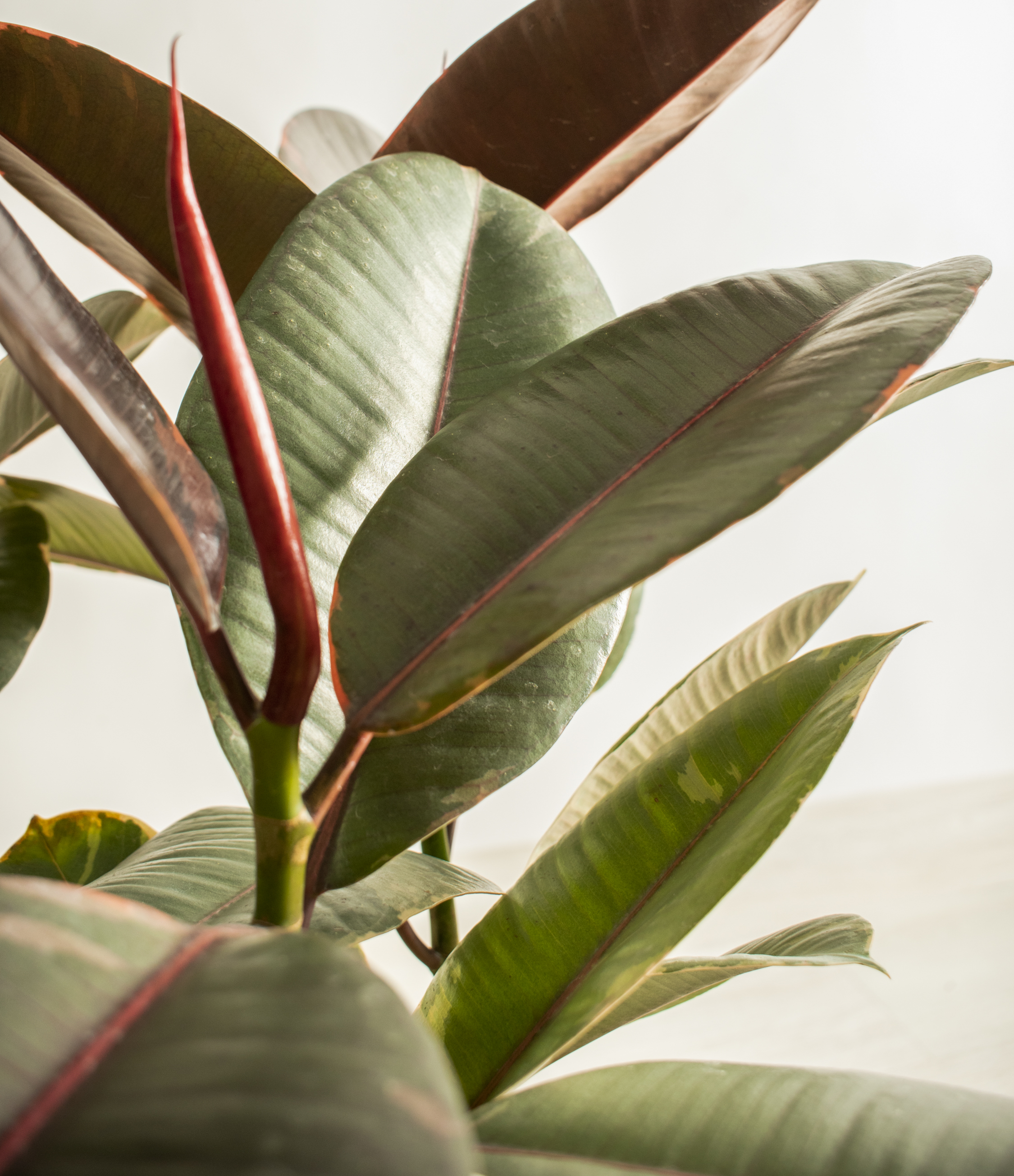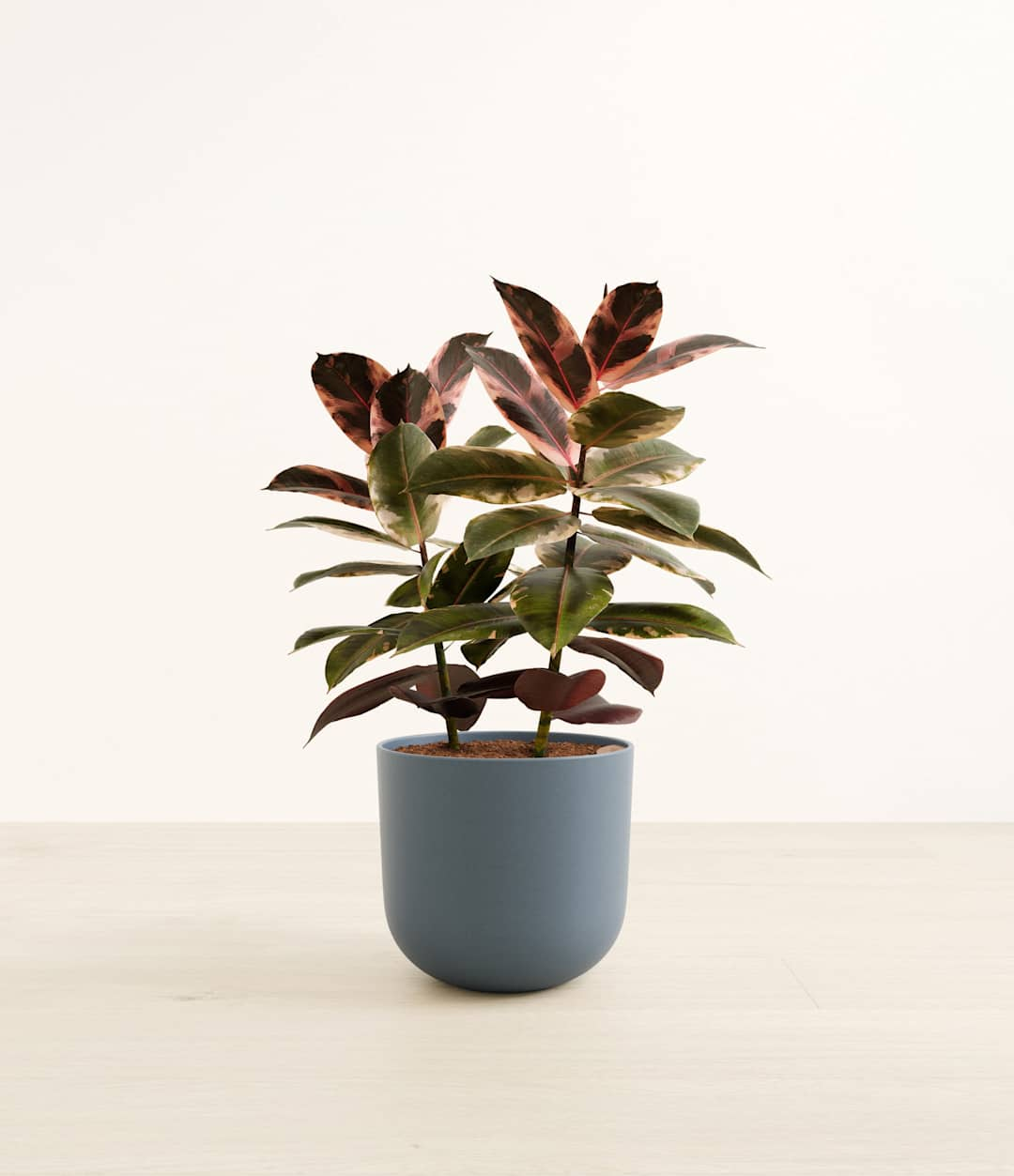Plant care library / Ficus Ruby
Ficus Ruby Care
Shop this plantAbout Ficus Ruby
The exquisite Ficus Ruby is a North East Indian native known for its colorful leaves and milky sap that can be used to produce rubber. Ficus Elastica is a beautiful rubber tree from the Moraceae or mulberry family. The Ficus ruby has been cultivated for rubber production, as the sap of the leaves contains latex.
Other common names
- Rubber Tree 'Ruby'
- Ficus Elastica 'Ruby'
- Ruby Red
- Red Ruby Rubber Plant
How Often Should I Water My Ficus Ruby
Watering is a delicate balance that can take time to perfect. Even plants that like to remain moist don't respond well to sitting in excess water and could develop plant diseases, including root rot. Luckily, with easyplant, watering your Ficus ruby plant is simple. Check the easyplant reservoir once a month, fill it when empty, and you're all set!
If you don't have an easyplant pot to make watering hassle-free, manually water your Ficus ruby when the two 1-2 inches of soil have dried out. Be sure to check the soil often as you're getting acquainted with your plant so it doesn't dry out completely. Ficus Elastica likes to remain uniformly moist but does not like sitting in water, so pour out excess water that accumulates in the saucer. Ficus ruby prefers distilled or rainwater, as chemicals can cause issues like browning leaf edges. If you use tap water, allow it to stay out overnight so some chemicals, like chlorine and fluoride, can dissipate.
Ficus Ruby Light Needs
Ficus Ruby grows best in a space with bright direct light, where the sunlight streams inside directly, and can also adapt to spaces with bright indirect light, where the sun rays are diffused. Avoid placing it in spaces with low light or spaces without natural sunlight.
The ideal place for the Ficus Ruby is a south-facing window directly in the path of light for the early morning hours. The intense afternoon sun exposure can burn the plant's leaves if it hasn't been acclimated to full sunlight. If that is the case with your plant, use a sheer curtain to diffuse the intense direct light in the afternoon.
Ficus Ruby Plant Care
The more indirect light the Ficus Ruby gets, the better the chances are that its leaves will retain their beautiful pink and ruby hues. To help it grow optimally and evenly, occasionally dust the leaves with a microfiber cloth and rotate the pot by a ¼ turn once a month. Rotation will ensure the leaves get the light they need on all of their leaves.
How Big Do Ficus Ruby Plants Grow?
Growth isn't just in a plant's overall height and width but also in its leaves. Typically rubber plants, like Ficus Ruby, sprout new leaves every 3-4 weeks. Each leaf grows to a length of 13 inches and spans 2-6 inches wide.
Ficus Ruby is a fairly slow-growing plant. The growth height depends on whether it's a house or an outdoor plant. Indoors, Ficus Elastica can reach up to 10 feet. This plant can grow to a staggering 50 feet out in the wild.
Due to its slower growth, it only adds 1-2 feet per year. Therefore, Ficus Ruby takes 5-10 years to fully mature. Various factors affect the growth of this plant, including sufficient lighting, regular watering, adequate humidity, and temperature levels.
Temperature & Humidity
Being native to a warmer climate, the ideal temperature for the Ficus Ruby is between 65-80˚F (18-27˚C). Any temperatures below 55˚F (13˚C) could negatively impact the leaves, causing them to become misshapen and eventually drop off. Be sure to keep Ficus Ruby away from drafts, heating, or A/C vents.
Ficus Elastica enjoys relatively high humidity. The ideal humidity level is between 40-60%. It can tolerate lower humidity levels, but if the edges of the leaves start to brown, try using a humidifier or group it with other plants in order to increase the humidity levels.
Are Ficus Ruby Toxic for Pets & Kids?
Some plants add a pleasing aesthetic to the home and can adapt well to the indoor environment but are unsafe to keep in the house. When considering a houseplant, it's important to know if anything toxic about the plant could harm children or animals if touched or ingested.
If ingested, the Ficus Ruby is highly toxic for people and animals, so keep it out of the reach of children and pets. For most people, the toxicity results in mild skin irritation. If ingested, it could result in vomiting or diarrhea.
The toxicity level is relatively low for most people, but for some, the latex in the sap can cause a severe allergic reaction. If you have an allergic reaction to the Ficus ruby, contact your physician or visit an emergency room near you.
Troubleshooting Common Problems with Ficus Ruby
Part of plant care is observing how your plant is fairing in its environment, so you can make adjustments if needed. Every houseplant will have different signs or tells when they aren't doing well. Here are a few things to look out for with the Ficus ruby and what to do to fix the issue.
If the leaves on your Ficus ruby start to lose their variegation in color, try moving the plant closer to a light source. Often, the leaves will become greener and plainer in color if they don't receive enough light.
If the leaves of the Ficus ruby are getting brown and crips, it could indicate that it's getting too much sun. Move the plant a bit further away from the window but still in the path of light. You can also use a sheer curtain to diffuse the light.
If you notice dried-up, dropping leaves, it could be due to underwatering or overuse of fertilizer. Pull back on the frequency of using fertilizer or dilute its strength. Check the soil more frequently and water when the top 1-2 inches are dry.
If you notice gray, green, or orange spots on the leaves of the Ficus ruby, these are Algal leaf spots caused by too much humidity. Cut off affected foliage and keep them dry. Use a humidifier to maintain humidity rather than misting.
If you notice yellowing leaves on your Ficus ruby and the stems are mushy, the plant may have root rot due to overwatering. Check the soil before watering; only water of the first 1-2 inches of soil is dry. You may need to repot the plant in fresh well-draining soil and remove any parts of the root ball that have turned black.
Ficus ruby plants may be prone to pests such as scale or mealybugs. These pests tend to congregate on the underside of leaves and appear like milky webbing or brown bumps on the leaves and stem. You can remove them with a microfiber cloth and some alcohol. You can also treat it with insecticidal soap or neem oil.
Frequently Asked Questions about Ficus Ruby Plant
- How Big Does a Ruby Ficus Get?The Ruby Ficus can grow up to 50 feet in the wild, but it gets to about 10 feet as an indoor plant. It is a slow grower, only adding 1-2 feet annually. Its slow growth means the plant won't fully mature until 5-10 years, depending on its environment and yearly growth rate.
- How Do I Make My Ficus Ruby More Red?The way to maintain or encourage your Ficus ruby's red or pink coloring is by ensuring it gets adequate sunlight. Place your plant in direct sunlight for the early morning hours, then pull back to indirect light in the afternoon when the sun gets hotter. Some Ficus ruby can handle full light all day long, but it's important to monitor it to ensure the leaves don't get scorched.
- How Often Should You Water a Ruby Ficus?The Ruby Ficus should be kept moist but never allowed to be left in sitting water. If you don't have a self-watering pot like the easyplant pot, check the soil before watering, and only water if the first 1-2 inches of soil is dry. If you check your plant and the topsoil is still wet, wait 24 hours and check again.

